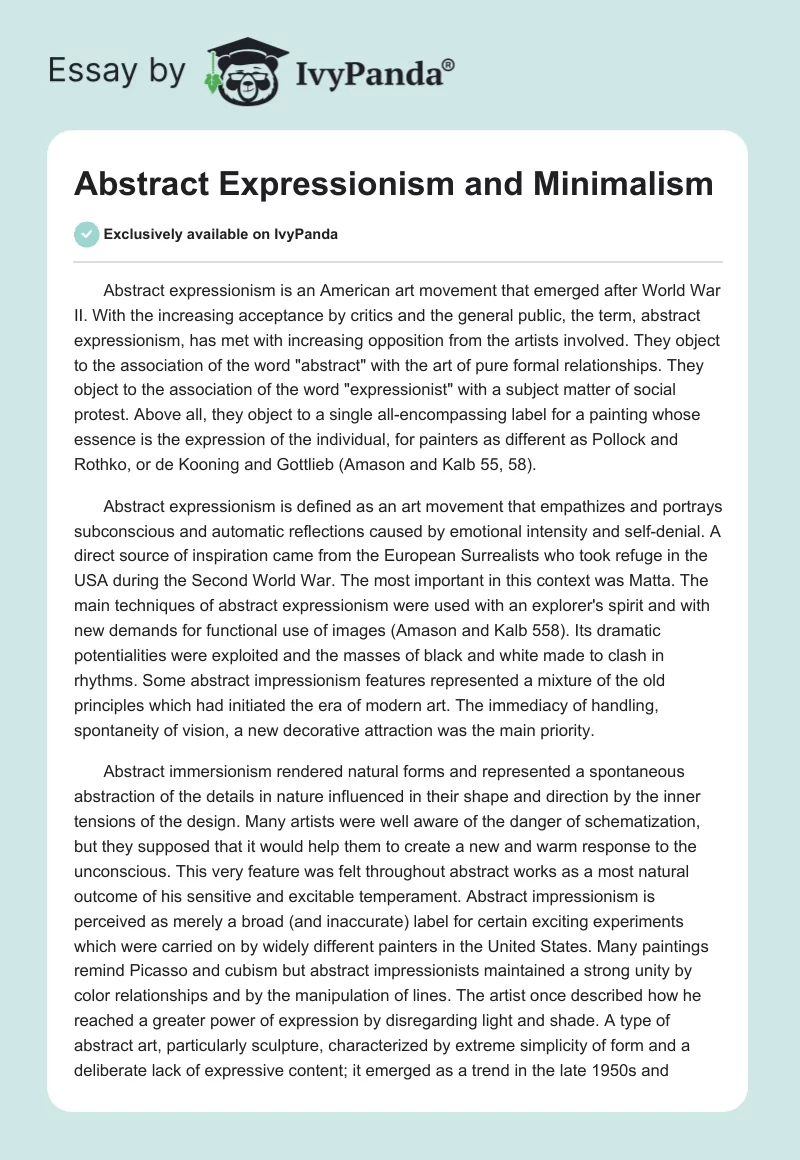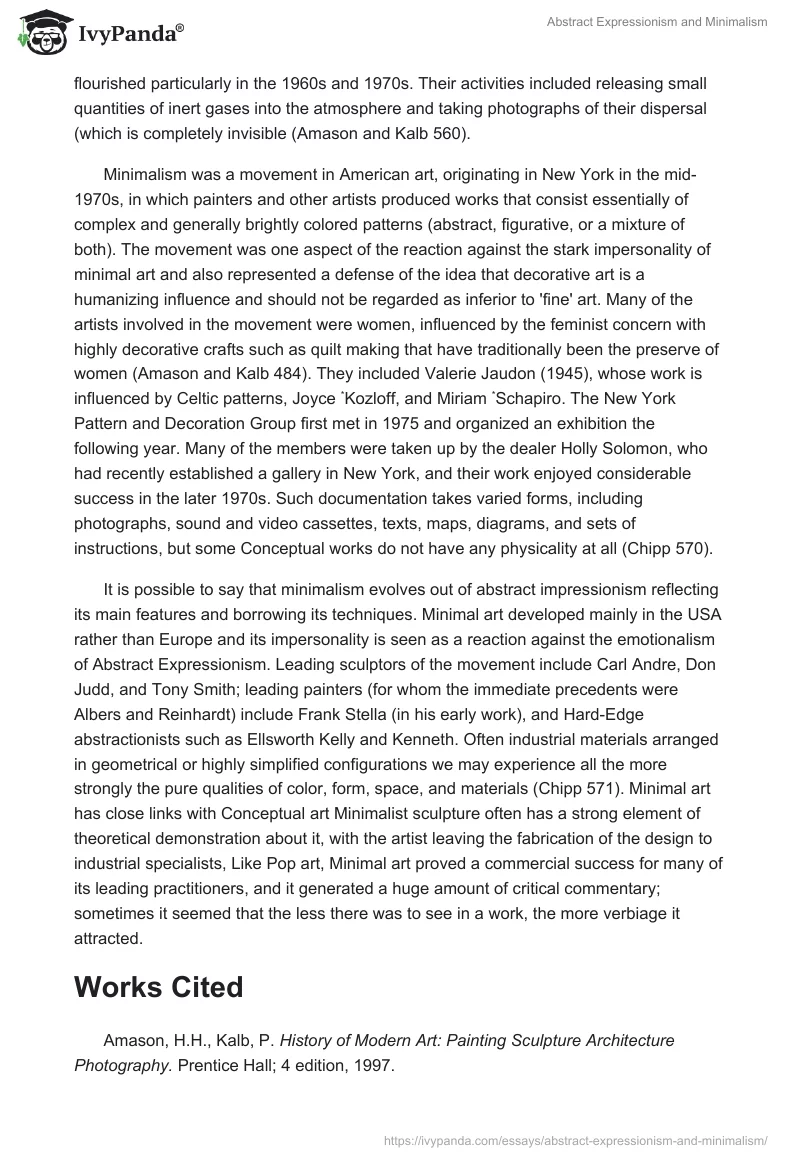Abstract expressionism is an American art movement that emerged after World War II. With the increasing acceptance by critics and the general public, the term, abstract expressionism, has met with increasing opposition from the artists involved. They object to the association of the word “abstract” with the art of pure formal relationships. They object to the association of the word “expressionist” with a subject matter of social protest. Above all, they object to a single all-encompassing label for a painting whose essence is the expression of the individual, for painters as different as Pollock and Rothko, or de Kooning and Gottlieb (Amason and Kalb 55, 58).
Abstract expressionism is defined as an art movement that empathizes and portrays subconscious and automatic reflections caused by emotional intensity and self-denial. A direct source of inspiration came from the European Surrealists who took refuge in the USA during the Second World War. The most important in this context was Matta. The main techniques of abstract expressionism were used with an explorer’s spirit and with new demands for functional use of images (Amason and Kalb 558). Its dramatic potentialities were exploited and the masses of black and white made to clash in rhythms. Some abstract impressionism features represented a mixture of the old principles which had initiated the era of modern art. The immediacy of handling, spontaneity of vision, a new decorative attraction was the main priority.
Abstract immersionism rendered natural forms and represented a spontaneous abstraction of the details in nature influenced in their shape and direction by the inner tensions of the design. Many artists were well aware of the danger of schematization, but they supposed that it would help them to create a new and warm response to the unconscious. This very feature was felt throughout abstract works as a most natural outcome of his sensitive and excitable temperament. Abstract impressionism is perceived as merely a broad (and inaccurate) label for certain exciting experiments which were carried on by widely different painters in the United States. Many paintings remind Picasso and cubism but abstract impressionists maintained a strong unity by color relationships and by the manipulation of lines. The artist once described how he reached a greater power of expression by disregarding light and shade. A type of abstract art, particularly sculpture, characterized by extreme simplicity of form and a deliberate lack of expressive content; it emerged as a trend in the late 1950s and flourished particularly in the 1960s and 1970s. Their activities included releasing small quantities of inert gases into the atmosphere and taking photographs of their dispersal (which is completely invisible (Amason and Kalb 560).
Minimalism was a movement in American art, originating in New York in the mid-1970s, in which painters and other artists produced works that consist essentially of complex and generally brightly colored patterns (abstract, figurative, or a mixture of both). The movement was one aspect of the reaction against the stark impersonality of minimal art and also represented a defense of the idea that decorative art is a humanizing influence and should not be regarded as inferior to ‘fine’ art. Many of the artists involved in the movement were women, influenced by the feminist concern with highly decorative crafts such as quilt making that have traditionally been the preserve of women (Amason and Kalb 484). They included Valerie Jaudon (1945), whose work is influenced by Celtic patterns, Joyce *Kozloff, and Miriam *Schapiro. The New York Pattern and Decoration Group first met in 1975 and organized an exhibition the following year. Many of the members were taken up by the dealer Holly Solomon, who had recently established a gallery in New York, and their work enjoyed considerable success in the later 1970s. Such documentation takes varied forms, including photographs, sound and video cassettes, texts, maps, diagrams, and sets of instructions, but some Conceptual works do not have any physicality at all (Chipp 570).
It is possible to say that minimalism evolves out of abstract impressionism reflecting its main features and borrowing its techniques. Minimal art developed mainly in the USA rather than Europe and its impersonality is seen as a reaction against the emotionalism of Abstract Expressionism. Leading sculptors of the movement include Carl Andre, Don Judd, and Tony Smith; leading painters (for whom the immediate precedents were Albers and Reinhardt) include Frank Stella (in his early work), and Hard-Edge abstractionists such as Ellsworth Kelly and Kenneth. Often industrial materials arranged in geometrical or highly simplified configurations we may experience all the more strongly the pure qualities of color, form, space, and materials (Chipp 571). Minimal art has close links with Conceptual art Minimalist sculpture often has a strong element of theoretical demonstration about it, with the artist leaving the fabrication of the design to industrial specialists, Like Pop art, Minimal art proved a commercial success for many of its leading practitioners, and it generated a huge amount of critical commentary; sometimes it seemed that the less there was to see in a work, the more verbiage it attracted.
Works Cited
Amason, H.H., Kalb, P. History of Modern Art: Painting Sculpture Architecture Photography. Prentice Hall; 4 edition, 1997.
Chipp, H. B. Theories of Modern Art A Source Book by Artists and Critics (California Studies in the History of Art). University of California Press, 1984.


